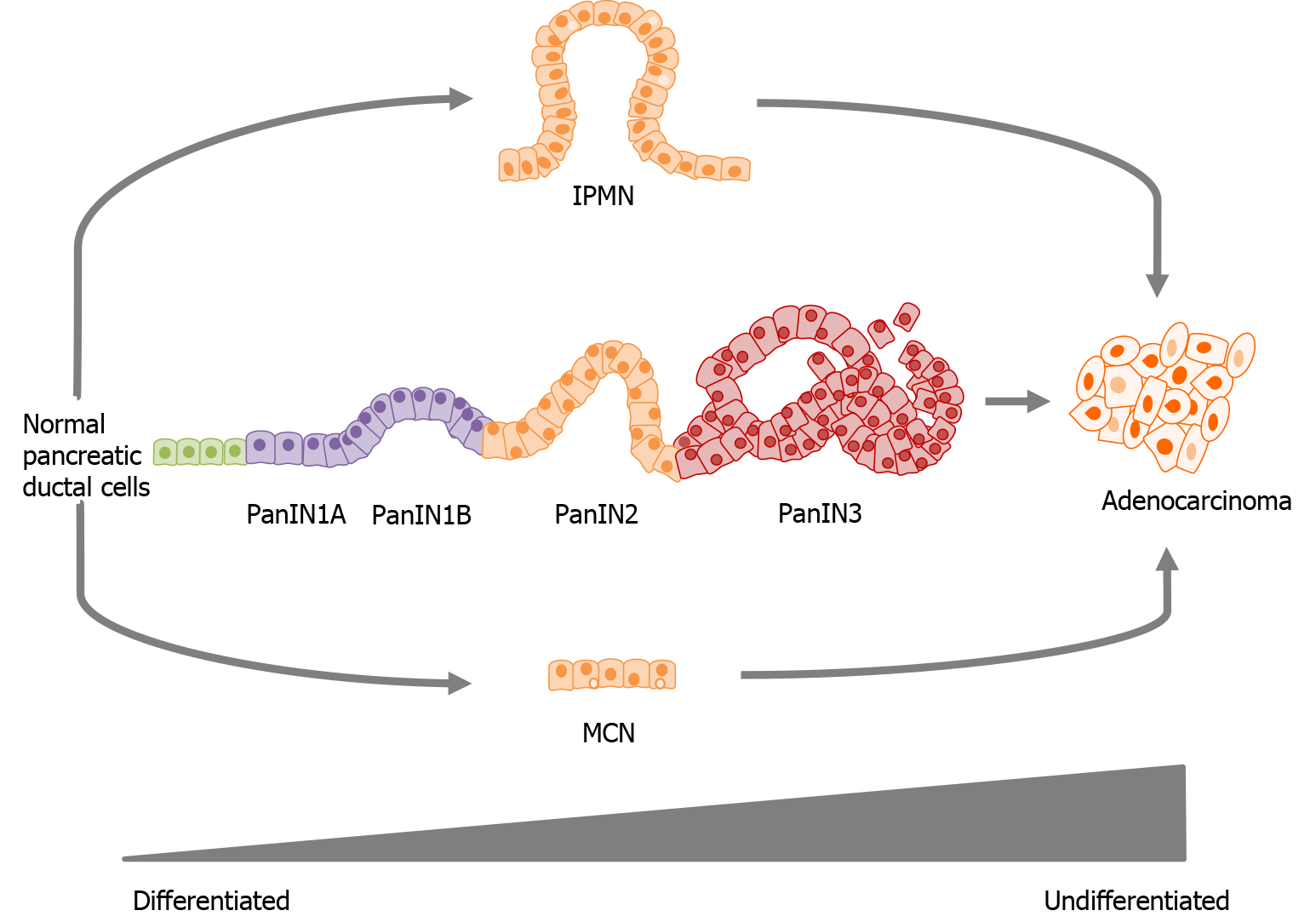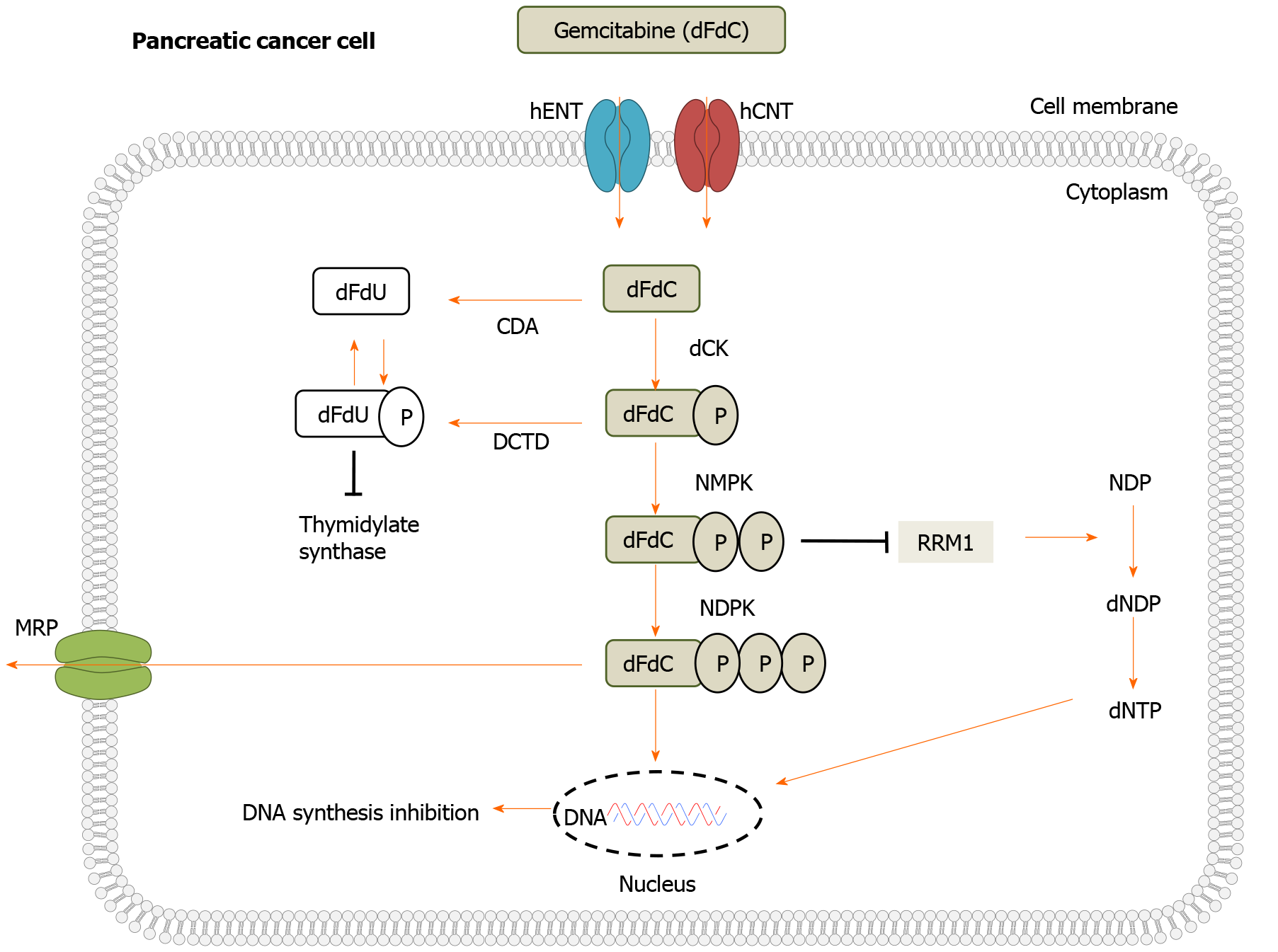Copyright
©The Author(s) 2021.
World J Gastroenterol. Oct 28, 2021; 27(40): 6844-6860
Published online Oct 28, 2021. doi: 10.3748/wjg.v27.i40.6844
Published online Oct 28, 2021. doi: 10.3748/wjg.v27.i40.6844
Figure 1 Pancreatic cancer progression beginning with normal pancreatic ductal cells which express MUC1, MUC5AB, MUC6, MUC17, and MUC20.
Pancreatic ductal cells progress to hyperplasia (PanIN21A/1B) with columnar cells, followed by dysplasia (PanIN2) with a loss of polarity, papillary and finally In-situ carcinoma (PanIN3) with a loss in cell polarity, papillary, budding off and mitosis. An increased expression of MUC1, MUC6, MUC16 and neoexpression of MUC3, MUC4, and MUC5AC can be seen in pancreatic intraepithelial neoplasia’s. Pancreatic ductal cells also progress into MCN which has an increased expression of MUC1 and the neoexpression of MUC2 and MUC5AC. Early Kras mutation as well as late SMAD4 and TP53 inactivation is seen in both PanIN and MCN. Finally pancreatic ductal cells can progress into IPMN which are mucin producing neoplasms that present with an increased expression of MUC1 and MUC6 as well as neoexpression of MUC2, MUC4 and MUC5AC. IPMN also presents with a Kras mutation and the inactivation of TP53 and P16/CDKN2A. IPMN and MCN further progress to adenocarcinoma where MUC1, and MUC6 expression is increased and MUC3, MUC4, MUC5AC, MUC5AB, MUC7, MUC13, MUC16 and MUC17 are neoexpressed[2-4,68]. IPMN: Intraductal papillary mucinous neoplasm; PanIN: Pancreatic intraepithelial neoplasia; MCN: Mucinous cystic neoplasm.
Figure 2 Schematic representation of Gemcitabine transport, metabolism, intracellular activation, and deactivation.
Gemcitabine (dFdC) is transported into the cell by nucleoside transporters: human equilibrative nucleoside transporter (hENT) human concentrative nucleoside transporter (hCNT) and is then catalysed by deoxycytidine kinase (dCK), which results in gemcitabine monophosphate (dFdCMP). It is then phosphorylated by nucleotide monophosphate kinase (NMPK) to gemcitabine diphosphate (dFdCDP). Finally, it is phosphorylated into gemcitabine triphosphate (dFdCTP) by nucleoside-diphosphate kinase (NDPK). Once metabolism is completed, gemcitabine enters the DNA resulting in the inhibition of DNA repair and replication. Gemcitabine or its phosphorylated metabolites are finally exported into the extracellular matrix by multidrug resistance protein 5 (MRP5)[22,26,27,41,69]. RRM1: Ribonucleotide reductase; CDA: Cytidine deaminase; DCTD: Deoxycytidylate deaminase; NDP: Nucleotide diphosphate.
- Citation: Carter CJ, Mekkawy AH, Morris DL. Role of human nucleoside transporters in pancreatic cancer and chemoresistance. World J Gastroenterol 2021; 27(40): 6844-6860
- URL: https://www.wjgnet.com/1007-9327/full/v27/i40/6844.htm
- DOI: https://dx.doi.org/10.3748/wjg.v27.i40.6844










